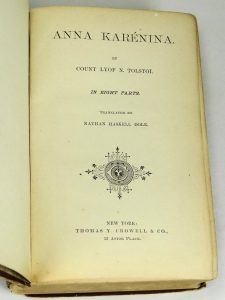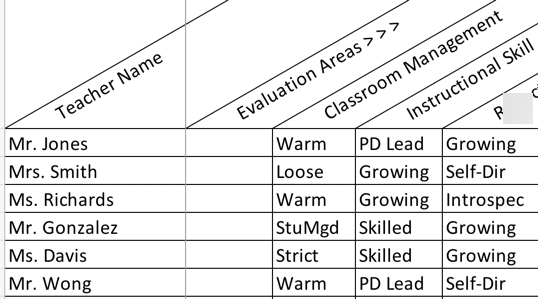Announcing an all-new mini-challenge as part of the Instructional Leadership Challenge…
 It's called the Anna Karenina Challenge, or #AKILC.
It's called the Anna Karenina Challenge, or #AKILC.
Tolstoy's 1878 novel, which has been called the greatest book ever written, starts with this unforgettable line:
“Happy families are all alike; every unhappy family is unhappy in its own way.”
You might be wondering…what on earth does this have to do with the Instructional Leadership Challenge?
Here's the parallel:
It's teacher evaluation time—the home stretch.
Administrators are scrambling to conduct observations, schedule post-conferences, and…the kicker…write final evaluations.
We know it's coming, and it always brings a little bit of dread, because it's…
Such. A. Huge. Task.
Yes, you have to rate each teacher, but you also have to write a bit about each teacher…
You often have to write a blurb for each of several specific topics, such as:
- Planning and preparation
- Instruction
- Classroom management
- Assessment
- Professional responsibilities
You can't just check a box that says “satisfactory” and move on.
It's like an essay test with 5 questions…that you have to take 30 times—once for each teacher.
Or…do you?
Think of Tolstoy's opening line again—let's start with the second part:
“every unhappy family is unhappy in its own way.”
So yes—every struggling teacher is going to need a custom-tailored, carefully-written evaluation that's unique to their struggles.
But what about the “happy families”?
What about the strong teachers—are they all alike?
Not exactly, of course…
…but they're not 100% unique, either.
Think of it this way: in any given performance area, teachers fall into one of just a handful of “types.”
Remember those “Which Spice Girl Are You?” or “Which Ninja Turtle Are You?” online quizzes? Kind of like that.
Great teachers are a LOT alike within a specific area—let's take classroom management. What are the types?
- Strict and no-nonsense, but still beloved
- Wacky but warm and accepting, with endless patience
- Not strict or wacky; just clear, consistent expectations
You can probably describe 80% of your staff with just 3-5 “styles” or “types” of classroom management.
For each type, you can just write one summary blurb:
“Mr. Baeder's classroom management is characterized by clear expectations, well-rehearsed routines and procedures, and a sense of humor that makes all students feel welcomed and accepted.”
If that's true for one teacher, it's probably true for a dozen others, too.
So re-use the blurb, because Mrs. Smith's classroom management is also characterized by clear expectations, well-rehearsed… etc. etc.
Then, you can do the same for their, say, planning and preparation skills.
3-5 types will cover most of the bases for a given area.
If you have to write blurbs about 5 areas per teacher, that's 15-25 blurbs in all—not the 150+ you'd normally write for 30 teachers.
These blurbs are the most time-consuming part of the writing process. So if we can save some time, it'll add up fast.
(The rest are likely your struggling teachers who will need much more customized language in their evaluations).
Now, can you just slap a label on a teacher and call it a day?
No, because teacher evaluations must be evidence-based.
So after the re-used blurb, you mention specific evidence from your observations:
“For example, on March 1, several students were off-task at the start of a lab activity, but they were immediately reminded of class expectations by their peers. This reflects Mr. Baeder's efforts to establish clear routines and procedures, and to create student ownership for them.”
If you have your observation notes in front of you, adding evidence should take about 90 seconds per blurb.
So here's where this is going to get fun…
We're building a collaborative list.
A list of areas of performance that you have to write about, with “types” for each area.
You can see what others have added, and contribute your own ideas.
I've drafted the document here—register for the Challenge, and we'll add you to the group as fast as we can, so you can edit the doc.
To summarize, the Anna Karenina Challenge is this:
Re-use your “blurbs” for teachers whose performance in a given area falls into the same category.
If two teachers are exactly alike in, say, their classroom management style, or their use of formative assessment, or their contribution to PLCs, you can use the same blurb to describe them both.
The evidence you provide will still be unique to each teacher.
But the hard part—the summary statement—can be re-used.
This can save you hours upon hours of writing…
Especially if we tackle it together.
Ready? Sign up for the Challenge here, we'll add you to the ILC group, and you can start contributing to—and getting ideas from—the collaborative document.
If you're already in the new ILC group, here's the doc to start editing.
I'd love to have your input on the “types,” especially if you're an instructional coach or classroom teacher. So sign up here—even if you don't actually evaluate teachers.
Part II
We're officially kicking off the Anna Karenina Challenge today!
If you evaluate teachers, here's your challenge:
Stereotype, then interrogate.
“Whoah, Justin, that sounds mean! What are you talking about?”
Now that I have your attention… 🙂
When doing teacher evaluations, you're making a lot of judgments about a lot of teachers in a lot of specific areas:
—Danielson: About 24 components
—Marzano: About 68, or perhaps 23 in the simplified model
—Marshall: About 60 components
If you have 30 teachers, and evaluate them on 23+ specific criteria, you're making at least 690 decisions as you
evaluate teachers.
But then…you have to write.
Exactly what you have to write about, and how much, depends on your district's policies and expectations.
But I'm guessing you have to write something for every teacher in each of several domains, like classroom management, or
planning & preparation.
What you write needs to be specific to each teacher…
But it doesn't need to be 100% “from-scratch” unique.
In fact, it's a huge waste of time to start your blurb-writing and summary-writing from scratch for every teacher.
Why? Because your great teachers have a lot in common.
As Tolstoy famously wrote, in the opening lines of Anna Karenina:
“Happy families are all alike; every unhappy family is unhappy in its own way.”
For example, teachers who are great at classroom management fall into one of just a handful of “stereotypes” or rough
categories: —Warm demander —Loose and student-centered —Tightly organized but student-managed
You might be thinking “I don't like those categories.” And that's fine! Make up your own list.
But make your list, and you'll see what I mean: it's a short list.
Your 37 teachers do NOT have 37 totally unique general styles of classroom management.
So start with their general approach. Stereotype.
(And yes, I know stereotyping is usually a bad thing. But we're going to use it carefully, for positive purposes.)
Write about that stereotype—once—and use the same stem in each teacher's evaluation.
If you have 11 “warm demanders,” write the same blurb about each warm demander.
Then, interrogate your assumptions (not the teacher…your assumptions :).
This is where you make the language unique to the teacher—which is important.
I wasn't very clear about this in my earlier email—someone took issue with what I suggested, and wrote back with this:
I usually read your messages with delight. However, I'm saddened by this one. We've worked very hard over the past years
to personalize teacher evaluation and to make it a growth process based on an individual's area of focus and using
evidence and specific information to tell the story of evaluation. I think you missed the mark with this one.
Now, I'll take responsibility for that, because I wasn't very clear.
It's essential to add specific evidence for each teacher after the generic blurb.
For example, your generic “warm demander” blurb might be:
“__'s classroom environment is characterized by high expectations, mutual respect, and warmth. __ consistently teaches,
models, and reinforces expectations for student behavior that are conductive to learning and respectful of students as
individuals.”
You can use that same intro blurb for all of your warm demanders.
But then, you must add evidence.
An evaluation with no evidence is just an op-ed, and we owe teachers more than that. Fortunately, you have a lot of
evidence by this point in the year.
“For example, during my November 14 observation, Mr. Smith used proximity and nonverbal cues to redirect a group of
students who were off-task during work time. As a result, other students were not interrupted, and the off-task group
quickly got back to work.”
And as you add evidence, you'll be accountable to yourself for interrogating your initial stereotype.
“Hmm, maybe this shows that Mr. Smith really isn't a warm demander…he's a little bit different, and here's how…”
So you'll end up with written evaluations that are, in fact: —Unique for each teacher —Based on specific evidence from
observations
So wait, what's the point again?
Your writing is vastly easier and faster when you start with generic blurbs, based on your general impression of each
teacher.
You aren't starting with a blank slate for each teacher. You're starting with your intuitive, summative judgment, then
testing that judgment against the evidence you've collected.
If the evidence doesn't match your judgment, now you know—and you can change your judgment to fit the evidence.
And because you can quickly categorize—or stereotype—each teacher based on that intuitive judgment, you can crank
through your evaluations very quickly.
To turbo-charge this approach, make a spreadsheet:
Take The Challenge & Get The Spreadsheet »
The spreadsheet is ere in the Instructional Leadership Challenge group on Facebook.
(Register, request access, and we'll approve you ASAP)
So here's where this is going to get fun…
We're building a collaborative list of stereotypes and blurbs…
…a list of areas of performance that you have to write about, with “types” for each area.
You can see what others have added, and contribute your own ideas.
I've drafted the document here. Register for the Challenge, and we'll add you to the group as fast as we can, so you can edit the doc.
To summarize, the Anna Karenina Challenge is this:
Re-use your “blurbs” for teachers whose performance in a given area falls into the same category.
If two teachers are exactly alike in, say, their classroom management style, or their use of formative assessment, or their contribution to PLCs, you can use the same blurb to describe them both.
The evidence you provide will still be unique to each teacher.
But the hard part—the summary statement—can be re-used.
This can save you hours upon hours of writing…
Especially if we tackle it together.
Ready? Sign up for the Challenge here, download the spreadsheet, and get started with your stereotypes.
Then, share your language here in the collaborative doc. (Desktop only—this is a new FB Groups feature.)

